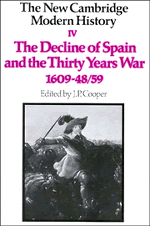Book contents
- Frontmatter
- INTRODUCTORY
- THE CENTRAL CONFLICTS
- Chapter IX Spain and Europe 1598–1621
- Chapter X The state of Germany (to 1618)
- Chapter XI The Thirty Years War
- Chapter XII The Low Countries
- Chapter XIII Sweden and the Baltic 1611–54
- Chapter XIV International relations and the role of France 1648–60
- THE UNMAKING AND REMAKING OF STATES
- THE FRONTIERS OF EUROPE
Chapter XIII - Sweden and the Baltic 1611–54
from THE CENTRAL CONFLICTS
Published online by Cambridge University Press: 28 March 2008
- Frontmatter
- INTRODUCTORY
- THE CENTRAL CONFLICTS
- Chapter IX Spain and Europe 1598–1621
- Chapter X The state of Germany (to 1618)
- Chapter XI The Thirty Years War
- Chapter XII The Low Countries
- Chapter XIII Sweden and the Baltic 1611–54
- Chapter XIV International relations and the role of France 1648–60
- THE UNMAKING AND REMAKING OF STATES
- THE FRONTIERS OF EUROPE
Summary
In the first half of the seventeenth century two states established themselves for the first time as great powers. The one was the United Netherlands; the other, Sweden. The period of their greatness was almost equal, and for both it was brief; each expanded into an empire of sorts; and each, perhaps, reached its zenith about the year 1660.
As far as Sweden was concerned, this rise to greatness was certainly unexpected. At the opening of the century it would have seemed doubtful whether the country could maintain its independence, and most improbable that it should ever become the leading power in the north. With the waning of the political ascendancy of the Hanse towns in the sixteenth century, that position appeared likely to fall either to Denmark or to Poland. There had, indeed, been a moment, in the 1560s and 1570s, when it looked at least possible that Muscovy might emerge as a formidable challenger: in the political convulsions which followed the collapse of the Livonian state of the Order of the Knights of the Sword, Moscow for a time won great successes, and the tsars came near to securing an extensive coastline on the Baltic; but the anarchy of the Troublous Times postponed for more than half a century any resumption of the plans of Ivan IV. The major portion of the lands of the knights fell to Poland; while Sweden maintained a precarious hold upon Reval and the northern coastlands of Estonia. It was the first of Sweden's overseas possessions, a nucleus around which other possessions would gather, and the need to defend it led Sweden step by step to ever deeper commitments in the politics of this region; but if it turned out to be in fact the springboard for imperial expansion, this was a development probably unforeseen in Stockholm, and certainly unlooked-for in Europe: in the years around 1605 it must have seemed much more likely that Estonia would soon be reunited to Polish Livonia.
- Type
- Chapter
- Information
- The New Cambridge Modern History , pp. 385 - 410Publisher: Cambridge University PressPrint publication year: 1970



